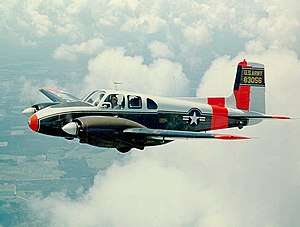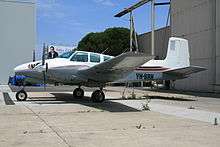Beechcraft Twin Bonanza
The Beechcraft Model 50 Twin Bonanza is a small twin-engined aircraft designed by Beechcraft as an executive transport for the business market. It was developed to fill a gap in Beechcraft's product line between the single-engined Model 35 Bonanza and the larger Model 18.[1] The Twin Bonanza is about 50% larger than the Bonanza, has more powerful engines, and is significantly heavier, while in its earliest form having only half the passenger capacity of the Model 18.
| Model 50 Twin Bonanza | |
|---|---|
 | |
| operated by the US Army as the U-8 Seminole | |
| Role | Utility aircraft |
| Manufacturer | Beech Aircraft Corporation |
| First flight | November 15, 1949 |
| Introduction | 1951 |
| Status | Active |
| Primary user | Private operators |
| Produced | 1951–1961 |
| Number built | 975 (includes 195 L-23) |
| Variants | L-23/U-8 Seminole |
| Developed into | Beechcraft Queen Air |
Development
.jpg)
The Twin Bonanza is not a true twin-engined derivative of the Bonanza since the cabin is wider and longer, however it did use some of the tooling jigs for the Bonanza as did the Travel Air (which was a closer derivative designed later).
The Twin Bonanza was first flown on November 15, 1949 after rapid development, begun only in April of that year.[2] The Model 50's type certificate was awarded in 1951,[3] and production began the same year. The United States Army adopted the Twin Bonanza as the L-23 Seminole utility transport, making it the largest fixed-wing aircraft in its inventory at that time. According to Ralph Harmon, the airplane's designer, during an initial demonstration flight for the Army, Claude Palmer, a Beechcraft Demonstration Test Pilot, crashed while trying to land over a 50-foot (15 m) tree line while full of soldiers and sandbags. Everyone on board walked away from the crash. The Army was impressed with the structural strength of the Twin Bonanza, eventually purchasing 216 of the 994 examples produced.[3] It was also the first twin-engined aircraft in its class to be offered to the business market, but the Korean War was raging in the early 1950s and the US Army took almost the entire production for 1952 and 1953.[1] The Beechcraft Model 65 Queen Air and Model 90 King Air are both direct descendants of the Model 50 Twin Bonanza. All three aircraft share the same basic wing design, as well as landing gear, flaps, instrument panels, fuel cells, and more. The Queen Air added a larger cabin to the design, while the later King Air added turbine power and pressurization. Twin Bonanza production ended in 1963[4] while the King Air was under development.
In January 2012 the Australian Civil Aviation Safety Authority issued an airworthiness directive grounding all Bonanzas, Twin Bonanzas and Debonairs equipped with a single pole-style yoke, having forward elevator control cables more than 15 years old, until they could be inspected. The AD was issued based on two aircraft found to have frayed cables, one of which suffered a cable failure just prior to takeoff and resulting concerns about the age of the cables in fleet aircraft of this age. At the time of the grounding some Bonanzas had reached 64 years in service. Aircraft with frayed cables were grounded until the cables were replaced and those that passed inspection were required to have their cables replaced within 60 days regardless. The AD affected only Australian aircraft and was not adopted by the airworthiness authority responsible for the type certificate, the US Federal Aviation Administration. The FAA instead opted to issue a Special Airworthiness Information Bulletin (SAIB) requesting that the elevator control cables be inspected during the annual inspection.[5][6][7]
Design
The Twin Bonanza is an all-metal low-wing cantilever cabin monoplane initially powered by two wing-mounted Lycoming GO-435 piston engines each with a wooden two-bladed propeller. The cabin has room for six people on bench seats, three in the front and three in the rear accessed by a side door on the right side.[8] To gain access to the door a retractable three-tread steps is used.[8] The Twin Bonanza has a tricycle landing gear with the nose wheel retracting rearwards and the main landing gears retracting partially into the engine nacelles, this leaves the tire exposed to assist in the event of a wheels-up landing.[8]
Variants

- Model 50
- Initial production version powered by two Lycoming GO-435-C2 engines, 13 built (six for the US Army, remainder civilian versions, with the first two production numbers for factory evaluation). As of 2010, only one Model 50 is still registered & flying (serial number H-7). As of June 2016, Serial Number H-7 is owned by W. Hulsey Smith through his holding company Archangel Technologies, LLC as part of the Archangel Collection.
- Model B50
- Upgraded Model 50 with increased takeoff weight, extra cabin windows and improved cabin heating, 139 built (40 for the US Army).
- Model C50
- Superseded the B50; fitted with 275 hp (205 kW) Lycoming GO-480-F1A6 engines, 155 built (one to United States Air Force).
- Model D50
- Superseded the C50; fitted with 295 hp (220 kW) Lycoming GO-480-G2C6 engines, 154 built (six to US Army).
- Model D50A
- Upgraded D50 fitted with GO-480-G2D6 engines, 44 built.
- Model D50B
- Upgraded D50A with new passenger steps and improved baggage area, 38 built.
- Model D50C
- Upgraded D50B with starboard airstair entry door, three rows of seats, improved air conditioning, larger baggage area, 64 built.
- Model D50E
- Upgraded D50C with extra portside window, squared-off rear starboard window, pointed nose and 295 hp (220 kW) Lycoming GO-480-G2F6 engines, 47 built.
- Model E50
- Supercharged version of the D50; with increased takeoff weight and 340 hp (250 kW) supercharged GSO-480-B1B6 engines, 181 built (mostly for the US Army).
- Model F50
- Supercharged version of the D50A with GSO-480-B1B6 engines, 26 built including one converted to G50 standard.
- Model G50
- Supercharged version of the D50B with 340 hp (250 kW) IGSO-480-A1A6 engines, increased fuel capacity and increased takeoff weight, one conversion from F50 plus 23 built.
- Model H50
- Supercharged version of the D50C with increased takeoff weight and IGSO-480-A1A6 engines, 30 built.
- Model J50
- Supercharged version of the D50E with 340 hp (250 kW) IGSO-480-A1B6 engines and increased takeoff weight, 27 built.
- Excalibur 800
- A modification designed originally by Swearingen Aircraft and taken over by the Excalibur Aviation Company which re-engines the Twin Bonanza with two 400 HP (298 kW) Avco Lycoming IO-720-A1A flat-eight engines in a new cowling and revised exhaust system.[9] Other optional improvements were also available.
- L-23 Seminole
- Military version
Operators
Military operators

- Chilean Air Force (5 x C50, 4 x D-50)[8]

- Colombian Air Force (1 x D50)[8]

- Royal Jordanian Air Force (1 x F50)[8]

- Royal Moroccan Air Force[10]

- Swiss Air Force (3 x E50)[8]

- Uruguayan Air Force
Specifications (D50)
Data from Jane's All The World's Aircraft 1956–57[11]
General characteristics
- Crew: 1
- Capacity: 5 passengers
- Length: 31 ft 6 in (9.60 m)
- Wingspan: 45 ft 3 in (13.79 m)
- Height: 11 ft 4 in (3.45 m)
- Wing area: 277 sq ft (25.7 m2)
- Aspect ratio: 7.51:1
- Empty weight: 3,981 lb (1,806 kg)
- Gross weight: 6,300 lb (2,858 kg)
- Fuel capacity: 180 US gal (150 imp gal; 680 L)
- Powerplant: 2 × Lycoming GO-480-C206 air-cooled flat-six, 295 hp (220 kW) each
Performance
- Maximum speed: 214 mph (344 km/h, 186 kn) at 2,500 ft (760 m)
- Cruise speed: 203 mph (327 km/h, 176 kn) at 7,000 ft (2,100 m) (70% power)
- Range: 1,650 mi (2,660 km, 1,430 nmi) at 10,000 ft (3,000 m) and 160 mph (140 kn; 260 km/h)
- Service ceiling: 20,000 ft (6,100 m)
- Rate of climb: 1,450 ft/min (7.4 m/s)
- Take-off run to 50 ft (15 m): 410 yd (1,230 ft; 370 m)
- Landing run from 50 ft (15 m): 458 yd (1,374 ft; 419 m)
See also
Related development
Aircraft of comparable role, configuration and era
- Aero Commander 500
- Cessna 401
- Piper PA-31 Navajo
- Piper Aerostar
References
- Phillips, Edward H., Beechcraft – Pursuit of Perfection, A History of Beechcraft Airplanes. Flying Books, Eagan, Minnesota 1992. ISBN 0-911139-11-7.
- Beechcraft Heritage Museum Twin Bonanza page retrieved December 26, 2007.
- "Beechcraft". Aerofiles: A Century of American Aviation. July 14, 2006. Archived from the original on October 18, 2006. Retrieved October 5, 2006.
- Twin Bonanza Model data Archived November 24, 2006, at the Wayback Machine retrieved December 26, 2007.
- Niles, Russ (January 15, 2012). "Australia Grounds Older Bonanzas". AVweb. Retrieved January 16, 2012.
- AAP (January 16, 2012). "CASA issues directive on light planes". Herald Sun. Retrieved January 16, 2012.
- Niles, Russ (January 24, 2012). "No FAA Bonanza Cable AD". AVweb. Retrieved January 26, 2012.
- Rod Simpson (June 2016). "The Beechcraft Twin Bonanza". Air-Britain Aviation World. Vol. 68 no. 2. Air-Britain. pp. 62–58. ISSN 1742-996X.
- Trammel 1966, p. 50
- Air International November 1985, p. 229.
- Bridgman 1956, p. 231.
- Bridgman, Leonard. Jane's All The World's Aircraft 1956–57. New York: The McGraw-Hill Book Company, Inc., 1956.
- "The Royal Moroccan Air Force...A Seasoned Air Arm". Air International, November 1985, Vol. 29, No. 5. pp. 226–232, 250–252. ISSN 0306-5634.
- Trammel, Archie (October 1966). "The Conversion Game". Flying. Vol. 79 no. 4. pp. 47–50.CS1 maint: ref=harv (link)
Further reading
- Aviation Media, Inc. Wonderful World of Flying. New York: Aviation Media, Inc, 1992. OCLC 704064237
- Beech Aircraft Corporstion. Beechcraft Bonanza. Wichita, Kan. : Beech Aircraft Corp., 1947. OCLC 797985508
- Beech Aircraft Corporation. The Story of Beechcraft. Wichita, Kan., 1969. OCLC 6164869
- Beech Aircraft Corporation. The World of Beechcraft. Wichita, Kan. : Beech Aircraft, 1973. OCLC 55965444
- Christy, Joe. Beechcraft Guide: Bonanza, Debonair, Musketeer. New York : Modern Aircraft Series, 1962. OCLC 1544220
- McDaniel, William Herbert. The History of Beech. Wichita, Kan. : McCormick-Armstrong Co. Pub. Division, 1982. ISBN 0-911978-00-3 OCLC 9093762
- Pelletier, Alain J. Beech Aircraft and Their Predecessors. Annapolis, MD. : Naval Institute Press, 1995. ISBN 1-55750-062-2 OCLC 33167975
- Phillips, Edward H. Beechcraft, Pursuit of Perfection: A History of Beechcraft Airplanes. Eagan, Minn. : Flying Books, 1992. ISBN 0-911139-11-7 OCLC 27046154
- Ward, Richard I. Beechcraft Twin Bonanza, Craft of the Masters: The Story of the Beech Civilian Model 50 & Military L-23/U8. Destin, FL. : Aviation Heritage, 1996. ISBN 0-9652727-1-0 OCLC 36105983
- Wixey, Kenneth E. Beechcraft. Stroud: Tempus, 1999. ISBN 0-7524-1617-0 OCLC 45308272
External links
![]()